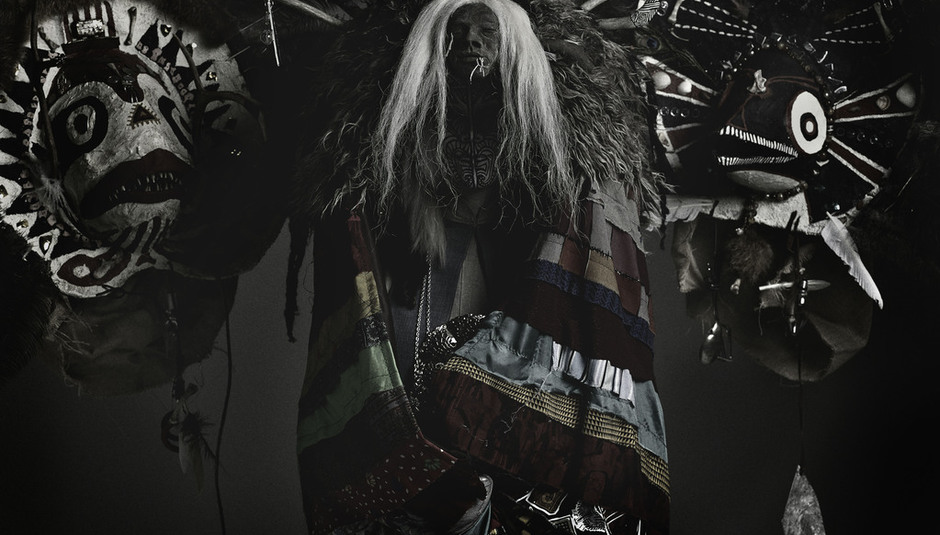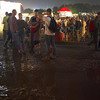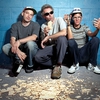Ahead of her performance as Fever Ray at the Loop festival in a few weeks time, DiS' Alexander Tudor got on the phone with Karin Dreijer Anderssen about various things including the commercialization of music, identity and an upcoming Opera about Darwin?!
DiS: The Fever Ray album has been one of my albums of the year, but it wasn’t guaranteed to appeal to everyone, so it was pleasing to see that it got such a good response. Were you surprised at all?
KDA: I don’t read much Press, but I’m pleased that people enjoy what I do.
DiS: When ‘If I Had a Heart’ came out, it felt a bit like a warning: this is a new band, and a different band, so don’t expect a big pop single. Was that a conscious decision when choosing that song?
KDA: I think it was a good introduction to the album… but Andreas Nilssen who made the video heard the whole album, and chose the one he wanted to make a video for. But I don’t think you can think about radio… and what will sound best on radio, you know? It’s more important to do something new.
DiS: Considering that people spend so much time trying to sound like each other – and yet singles sell less than ever – would you expect to see a move towards people putting their most interesting songs out, instead?
KDA: Yes, but I don’t know much about what other people are releasing. I know that in Sweden, the radio has become much more commercialized. They don’t even play The Knife on the radio.
DiS: In some of your previous interviews, you mentioned some of the people you’ve been listening to, and some of your influences, mentioning some unfamiliar names. Can you a bit about them?
KDA: I didn’t have many expectations when I went into the studio, but I listened a lot to a band called Tomahawk, and they made an album inspired by Native Americans… and that was quite a big influence on this work [especially] the tempo. I wanted to make something slow, and to find out what was my ideal tempo. Also, there was a film by Jim Jarmusch, Dead Man, which filtered into the way I made the album.
DiS: The music’s improvised by Neil Young, isn’t it? I know you played most of the instruments yourself, but did you invite any of the other musicians to improvise?
KDA: I did all the programming, and the guitar is me, but I got someone to play the double-bass, which I can’t play. In the end I got three different producers to help with the final version.
DiS: I’m sure a lot of journalists – when they’re talking about The Knife or Fever Ray – talk about the masks, and disguise. Do you feel that part of the appeal of electronica, to you, is that you’re able to conceal your culture and your identity?
KDA: I think it’s interesting to just focus on the music. When everything is so commercialized, you’re expected to talk about fashion, and lifestyle, and what car you’re driving. So, it’s a challenge these days, to focus on what you’re working on. For me it’s music. I don’t see it as disguise… I just see it as trying to express something about the music, and to follow it in a good way, to get the attention on the music.
DiS: Absolutely! I didn’t want to take anything away from the music, and underplay the importance of it, but the music itself – especially the distorted vocals – and the lyrics are often making a comment about the nature of identity, and the artifice of identity.
KDA: Yes. That’s a good way to see it. I think, it’s been easier or more common with electronic music… I’m not sure what to call it… to play with images, certainly if you compare it to [rock]. I mean, Sweden has been very rock-oriented, and, for instance, Bruce Springsteen comes here every summer now, and that’s the biggest thing that comes here. We’ve been making music as The Knife for ten years now, and it’s still very…
DiS: Frustrating…?
KDA: Um… yes! [laughs]
DiS: Where do you find you get the best response?
KDA: I suppose in Germany, where they have a lot of electronic music, and Belgium and Holland, where they have a history of more performance-based acts, which I can relate to. Acts who are more theatrical.
---
Triangle Walks from Fever Ray on Vimeo.
---
DiS: Are there plans to film the Fever Ray shows, in the way that Silent Shout was? [The album has been re-released, accompanied by Silent Shout: An Audio-Visual Experience on DVD & CD, including a video of the highly elaborate Gothenberg concert.] It’s pretty much the only concert-video I'll actually put on and watch…
KDA: We haven’t planned anything yet, but we want to do it. We’ll see what happens…
DiS: The music critic Simon Reynolds theorizes that dance music has a tendency to be utopian, whereas The Knife appealed to me because they seemed to subvert dance music sounds to create something dystopian - even on the Fever Ray album, where it’s a more domestic setting.
KDA: I think you can find that emptiness in all kinds of music… where it’s all about parties, or whatever. I’m just not into all that! Into clubbing… not in the last ten years at least. It’s very much for myself. It only becomes social when you start to work for other people, on the visuals… with the video-directors. At first, I think it’s for myself.
DiS: Listening to the Fever Ray album, some of the songs seem like messages to your children, or reflections on how they’re going to grow up, particularly the first song…
KDA: It’s so much about what I’m doing at home, that I don’t expect them to respond to it. I’m really happy now that they’re starting to get their own ideas about music… they’re watching YouTube… and find their own things, but it’s not their fault [what they find]!
DiS: ‘If I Had a Heart’ seems to come from the fact that you want to feel more emotion than you do [having just had a second child], but you can’t because you’re so tired… and the [delivery of the] song, the use of the vocal effects, makes that simple situation much more sinister.
KDA: Yes, but in music you have the possibility to play with ideas, and find out what they might mean. You know, that’s the worst thing you can say as a new mother – that “if you had a heart, they could love you” – and so it’s very important that you have these areas where you can try these ideas. After that, I say, “If I had a voice, I could sing”, but I am singing, so it’s not a dead end. Everything I say isn’t real. Sometimes people – how do you say it? – ‘bare themselves blind’? Art is a way to try and think differently…
---
When I Grow Up from Fever Ray on Vimeo.
---
DiS: Thinking of the different voices across the album, it seems you often have very specific ways of using them, but some are more open-ended. On ‘Concrete Walls’ it’s clear why you’re using the slurred, weary voice, but on ‘I’m Not Done’ [which is about no longer being a young woman trying to make a career in pop music], there’s a contrast between the much higher and lower voices that suggests (to me, at least) that the one is parody of a young voice, and the other is the spectre of old age. Were there other places you had a specific intention?
KDA: Yeah… on ‘I’m Not Done’, I wanted the vocal to be a bit annoying, and not so comfortable to listen to. Often, I don’t want my vocals to be easy to listen to. There, I really wanted to find a voice that was a little bit hysterical, and annoying. That’s almost the first thing I started to do with each track, was to find the sound of the vocal – to find the pitch, or if it’s supposed to be sung out loud, or whispered, or what. But I always find the style of performance of the vocal very interesting. It’s very important to me, how it ends up.
DiS: On the second last track ['Keep the Streets Empty for Me'], you’re singing as an animal… but it’s one of the most natural voices, which seemed deliberately ironic.
KDA: Yes, that’s my natural voice, but it’s also a duet. It’s unprocessed… but it’s supposed to be a deer singing. It works with the contrasts. [I find] it’s good when you work in the album format, creating tracks that are supposed to go along with other tracks, adding up to something bigger, rather than just working with singles.
DiS: How is your brother’s project going? [Making field-recordings in the Amazon]
KDA: [Referring to a solo album…] You’d have to ask him about that… Oh, you mean the opera! Yes, the opera is something we’ll be doing together – he just has some other stuff going on. We’ve been working on that project for about one-and-a-half years, and it’ll soon be finished. A Danish opera company commissioned some music for an opera about Charles Darwin, and we’ve now started rehearsing with the singers, in Copenhagen, and we will continue in August, and premier in September. It will be touring around, throughout the Fall, and next year. One of their productions has been touring for fifteen years… so, we’ll see how long it will last!
DiS: I’m sure there’ll be a lot of interest [since so much is going on to mark the 150th anniversary of The Origin of Species]. Do you have a personal interest in Darwin, or did they approach you, and you said ‘Sure, why not?’
KDA: I think, when they approached us – Hotel Performa, as they’re called – we saw that they’d made some interesting works before. I hadn’t read anything about Charles Darwin when I started, but now I’ve read so much. It’s a huge subject. Everything relates to his theory, and so you get a new perspective.
DiS: A Swedish friend told me it’s frightening that Creationism can be taught in the UK, as if it’s a scientific theory…
KDA: In Sweden, we didn’t know anything about Creationism. My brother lives in Berlin, though, and an American friend – when he said that we were working on Darwin – asked ‘Oh, do you believe in that?!’ I think it’s about one-third of the American population who believe in Creationism, and that is frightening, for us in Sweden. But [in our opera] we focus on Darwin’s view of diversity, and how it’s very un-hierarchical. So, it’s a very positive focus, I think.
DiS: Ah, that’s interesting, because I had thought it made sense for you to be looking at a Naturalist, or a biologist, because there’s so much animal imagery in your work, and images of the natural world, but that [emphasis on diversity and a lack of hierarchy] fits with something else which I see in The Knife & Fever Ray, which is the blurring or mixing up of gender identity [again, through the voices, and various images], as if gender is chosen, or put on. Could you tell me about that?
KDA: I’m not sure where it comes from. I mean, in Sweden, these issues have been discussed for quite a long time, and we consider ourselves fairly equal, although of course there’s so much more to do. I think that [associating] gender with skill or power is very limiting to humans. So, I think we are trying to broaden the areas where you’re supposed to work, as a woman or a man.
DiS: Although, at the same time, it seems very positive to be writing an album that’s so much about the experience of parenthood, when there’s very little of that [in indie music, and/or electronica]
KDA: I didn’t start out to do that, but I mostly wrote about what was going on. I think most things you read as a parent, are about how it’s all fluffy and wonderful, but when you become a parent, you also get drawn into all these new perspectives. You get a totally new look on – at least I did – on life, and also death. You realize the line is very fine, and I realized that in everyday life, I hadn’t been thinking about that much. It’s like the whole world turns upside down.
DiS: Is a song like ‘Concrete Walls’ quite representative? In that it’s very oppressive…
KDA: Well, that was where I took things to the edge – there is a lack of sleep, and the screaming colic[ky] kids – but I took that to the edge, and then I was able to realize that it’s nothing real… it’s not too hard anymore. [laughs]
DiS: Similarly, on the previous album as The Knife, the song ‘Silent Shout’ seems to be about someone with profound anxieties about gender identity… but is that then an extreme case to draw attention to how everyone’s identity is constructed?
KDA: Yes, I absolutely think so. It’s a bit scary when you see how everything’s constructed. You wait to see what’s going to happen to your kids… to see how they’ll be when they get older. They’re going to grow up in a society that moulds them, and you think you can avoid that, but you can’t.
DiS: Thinking of the shows you’ll be doing at the Loop festival, can you give us a taster of the shows?
KDA: We’ll be working with Andreas Nilssen again – who did the visuals for The Knife, and the ‘If I Had a Heart’ video. It’s going to be very theatrical. There should be costumes, and videos, and smoke, and lasers.
---
If I Had A Heart from Fever Ray on Vimeo.
---
DiS: Is there anyone else you’re looking forward to, at Loop?
KDA: The Field…? I haven’t been to Brighton, so I’m looking forward to that.
DiS: And what comes next? Is there going to be another Fever Ray album?
KDA: I’ll be touring for the rest of the year, and then we go into the studio to record Tomorrow in a Year, the opera.
Fever Ray will be playing at LOOP FESTIVAL 2009 (July 10 - 12)
12.00 midday – 03.00am, Victoria Gardens, BrightonVisit www.loopbrighton.com for last year’s picture gallery and film footage, or go here for tickets.
Loop on Myspace






















